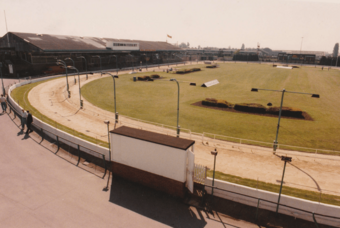Romford Greyhound Stadium facts for kids

Romford Greyhound Stadium around 1980
|
|
| Location | London Road Romford Greater London RM7 9DU England |
|---|---|
| Operator | Entain (Ladbrokes Coral) |
| Capacity | 1,700 people |
| Construction | |
| Opened | Old track 1929 New track 1931 |
| Renovated | 2019 |
| Tenants | |
| Greyhound racing | |
| Website | |
| Official website: https://romfordgreyhoundstadium.co.uk/ | |
The Romford Greyhound Stadium, also known as Coral Romford Greyhound Stadium, is a special place in Romford, east London. It's where greyhound racing happens, a sport where speedy dogs race around a track. The stadium can hold more than 1,700 people! It's owned and run by the Ladbrokes Coral group.
This stadium has won awards, like 'Racecourse of the Year' in 1998 and 2003. Since January 2025, it has been the only greyhound racing stadium left in London and the wider Greater London area.
Contents
Greyhound Racing at Romford
The track at Romford is 350 metres long in a circle. The greyhounds race different distances, including 225, 400, 575, 750, and 925 metres. Imagine how fast they must be to cover those distances!
When Can You See a Race?
There are six race meetings every week. You can catch races on Friday and Saturday evenings, Wednesday and Saturday mornings, and Monday and Thursday afternoons. In December, there are also races on Tuesday evenings.
How Betting Works
At the stadium, people can place bets on which greyhound they think will win. You can do this at the Tote or with special track-side bookmakers. It's all part of the excitement of race day!
Big Races and Competitions
Romford Greyhound Stadium hosts several important races each year. These include famous events like the Cesarewitch, the Champion Stakes, the Essex Vase, the Romford Puppy Cup, the Golden Sprint, and the Coronation Cup. These races attract some of the best greyhounds.
Stadium Facilities
The main building at the stadium is called the Coral grandstand. It's located right at the finish line and has two levels. Inside, you'll find two public bars, The Champions Bar and La Roc Bar, plus the Trap 7 Snack Bar. There are also places to place your bets.
Dining at the Stadium
The Coral grandstand also has the Paddock Restaurant, which can seat 200 people. This grandstand was completely updated and reopened on September 6, 2019, after a huge £10 million renovation! There's another restaurant called The Pavilion on the third bend, which can serve 100 diners. Plus, a special Marquee on the fourth bend has its own bar, snack bar, and betting facilities.
A Look Back: Romford Stadium's History
Romford Greyhound Stadium has a long and interesting past, starting way back in the 1920s.
Early Days and the First Tracks
In 1929, two men, Archer Leggett and his brother-in-law, started greyhound racing on a small piece of land in Romford. They used a hare pulled by an old Ford car engine! This first track only lasted a year because the rent became too expensive.
So, in 1931, they built a new track with a stand in a different field. This new site had a hand-operated scoreboard and an electric hare. The first race meeting there was on September 20, 1931, and over 1,000 people came to watch! By 1935, new directors joined, investing £17,000 to turn the track into a proper stadium with more stands and kennels for the dogs.
When Cheetahs Raced!
Here's a fun fact: in the 1930s, someone tried to make cheetahs race in the UK! Twelve cheetahs arrived from Kenya in 1936. After getting used to their new home, they raced for the first time on December 11, 1937, at Romford.
However, the experiment didn't work out. Even though cheetahs are super fast, they lost interest in chasing the lure when racing against each other. So, after just two races, the cheetah racing stopped.
Growing After the War
After World War II, Romford Stadium continued to grow. In 1976, the stadium was sold to Corals, a big betting company. The new owners invested a lot of money, building a new grandstand with a fancy glass-fronted restaurant. These improvements made the stadium very popular.
One of Romford's most famous moments happened in 1982 when a greyhound named Lauries Panther won the English Greyhound Derby. Other famous greyhounds like Ballyregan Bob and Scurlogue Champ also raced at Romford. Over the years, more big races like the Coronation Cup, the Golden Sprint, and the Champion Stakes were added to Romford's calendar.
Romford in the 21st Century
In 2006, the main restaurant in the grandstand got a £400,000 makeover. Then, in 2019, the stadium had a massive renovation costing millions of pounds. They even built a brand new grandstand and laid down a new track! The stadium stayed open during most of the work and officially reopened on September 6, 2019.
In 2020, the Cesarewitch competition, a very old and important race, was brought back to Romford. Today, Romford Greyhound Stadium continues to be a busy and exciting place for greyhound racing fans.
Current Track Records
These are the fastest times recorded by greyhounds at Romford on the current track.
| Distance (Metres) | Greyhound | Time | Date | Notes |
|---|---|---|---|---|
| 225 | Chopchop Rainbow | 13.17 | 28 October 2022 | |
| 400 | Roxholme Nidge | 23.26 | 15 September 2017 | Romford Puppy Cup heats |
| 575 | New Destiny | 34.53 | 14 June 2024 | Coronation Cup final |
| 750 | Avit on Bertha | 46.37 | 12 December 2012 | |
| 925 | Riverside Honey | 58.57 | 6 September 2019 | TV Trophy heats |
| 1100 | Cregagh Prince | 72.59 | 10 March 1987 | |
| 400 H | Glenwood Dream | 24.07 | 12 March 2010 | |
| 575 H | El Tenor | 35.53 | 19 February 1999 |

